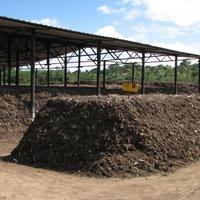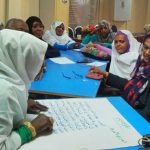
Research recommends composting as a viable option for solid waste management in Sri Lanka
Solid waste management is growing as a major problem in urban Sri Lanka with a rising population and rapid urbanization. The present system of open dumping has caused environmental and public health hazards, a research study has found. The research published in the NSBM Journal of Management, which is hosted on the INASP-supported Sri Lanka Journals Online platform (SLJOL), recommends the composting of organic matter as the most socio-economically viable method of waste management.
Researchers Dr T. Lalithasiri Gunaruwan, Senior Researcher at the Department of Economics at the University of Colombo, and Ms W. Neluka Gunasekara of the Institute of Policy Studies, Sri Lanka studied the viability of using composting as a method of solid waste management. The study also compared different variations of the composting models being used by various urban councils in Sri Lanka including Weligama, Balangoda and Bandarawela.
While the models adapted by different urban councils varied in investment and efficiency, composting as a general method appeared to have economic viability and was found to be a better option than the present system of open dumping.
The Weligama Model is based on the actual experience of composting in the plant established by Weligama Urban Council, while the Pilisaru Model is a standard model stipulated by the Pilisaru Project of the Sri Lankan Central Environmental Authority. The Ministry of Environment has directed and provided resources for the implementation of the Pilisaru Project in some 115 local authorities. The urban councils have been given authority to customize the model according to local needs.
According to Dr Sumith Pilapitiya, a solid-waste management expert in the country, the Pilisaru Project was developed to replicate and upscale the Weligama Composting model in which much more liberal infrastructure investments were made. The two models use the same basic technology but Weligama urban council has spent less on infrastructure. The low capital intensive Weligama model produced only 1 to 1.5 metric tonnes of compost per 18 metric tonnes of solid waste. The Pilisaru Model was more technically productive with an output of 3 tons of compost per 18 tonnes of waste.
The Weligama plant was established by Weligama Urban Council in Southern Sri Lanka with a cost of Rs 11 million in 2011 while the Pilisaru model requires Rs 23 million for the installation.
The Sri Lankan government previously did not have sanitary landfill sites or any large-scale composting plants. However, some local authorities like the Weligama, Balangoda and Bandarawela had been experimenting with their own mini composting plants.
The research found that composting solid waste might not have huge monetary benefits, but has a lot of indirect benefits. It contributes immensely towards the improvement of public health and the environment. Organic manure produced from composting can partially displace the use of chemical fertilizer. The government expenditure towards subsidies of chemical fertilizers could be reduced. Land that would otherwise be wasted for landfill could be put to more productive use.
Composting is considered to be the best approach as the composition of solid wastes in Sri Lanka is predominantly organic. According Dr Gunaruwan, decomposable organic matter makes up 60-65% of the total solid waste composition in Sri Lanka. The remainder is plastic, paper, metal and glass.
Dr Gunaruwan adds, “While our research focuses on composting of decomposable waste, the recycling of reusable materials is equally important in terms of overall solid waste management.”
The appraisal showed that, the Pilisaru Model, producing at its maximum, would not have the possibility to attain financial viability without lowering the cost of operation and installation. However, the Weligama Model stood a good chance of attaining financial viability as its operation and installation costs were low and many areas could be improved to increase efficiency. Dr T. Lalithasiri Gunaruwan says, “At present, the Weligama Model is less capital-intensive and less efficient. If it can be redesigned to increase the efficiency, maybe through appropriate capital injections in technology, then it has the potential of becoming financially viable.”
“The conclusion of this study is, in our part of the world, where organic matter is the chief composition of solid waste, composting is the best option. If managed well, the solid waste offers the potential of becoming an asset to the local authorities, instead of being a headache,” says Dr T. Lalithasiri Gunaruwan.
For more information, see: Gunaruwan, T. L., & Gunasekara, W. N. (2016), Management of Municipal Solid Waste in Sri Lanka: A Comparative Appraisal of the Economics of Composting, NSBM Journal of Management, 2(1), 27–45. The journal and the article are made available online on the SLJOL platform, which is supported by INASP.
About the Journal
NSBM Journal of Management is published by the National School of Business Management (NSBM), Colombo. The principal objective of the journal is to provide a medium for disseminating findings of study and research addressing issues, practices and developments in Management.
About SLJOL
Sri Lanka Journals Online (SLJOL), a part of INASP’s Journals Online, is a database of journals published in Sri Lanka, covering the full range of academic disciplines. The objective of SLJOL is to give greater visibility to the participating journals and to the research they convey. It is managed by the National Science Foundation of Sri Lanka and was developed in collaboration with INASP. There are now 69 journals on SLJOL listing 7622 articles.
About INASP
Founded in 1992, INASP is an international development charity working with a global network of partners in Africa, Latin America and South Asia. In line with the vision of research and knowledge at the heart of development, INASP works to support individuals and institutions to produce, share and use research and knowledge, which can transform lives.
INASP’s approaches are based on the core pillars of capacity development, convening, influencing and working in partnership. INASP promotes equity by actively addressing the needs of both men and women across all our work and addressing issues of power within the research and knowledge system. INASP has projects in 28 countries, supporting all aspects of research and knowledge systems, from facilitating the provision of information to researchers to helping parliamentarians and civil servants to use research and evidence in policy making.
Disclaimer: Research published in journals hosted on the SLJOL platform is selected by the journals in accordance with their own editorial processes and criteria. INASP and the National Science Foundation of Sri Lanka provide hosting and guidance on good practices but are not involved in selection of research.
For further information
Thakur Amgai, Communications Consultant, INASP
Email: tamgai@inasp.info
Dr Sangita Shrestha, Communications Officer, INASP
Email: sshrestha@inasp.info

 Previous Post
Previous Post Next Post
Next Post


